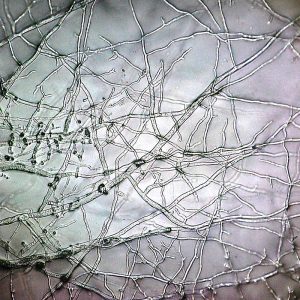Is Mycelium the Material of the Future?
No, mycelium is not a recently discovered chemical element. It might be the solution to the question of how to replace petroleum-based materials!
Mycelium is the tenuous web of vegetative fungal cells called hyphae that grows in the soilas shown in figure 1.[1] The parts of fungi that we usually see are just their body fruits (mushrooms, chanterelles, shiitake,…). But mycelium forms a much larger network below the surface that can even spread over several thousand square kilometers.[2] It is one of earth’s most important organisms since it helps nature to “digest”, meaning that it decomposes organic material and turns it into compost.[1]
But can this bio-based material save our planet? The answer to this question could be easier as you might think. Fungal material is renewable, compostable under certain conditions (moisture and the presence of other organisms), fire resistant, moldable, free from volatile organic compounds (VOCs), dyeable and vegan.[4]Companies like Ecovative and MycoWorks have already started to produce items from mycelium that can find access to our daily life.[4,5]
Ecovative was founded in 2007 and claims to produce more than 450,000 kg of mycelium material per year. They explain the production process on their webpage:
Agricultural waste is seeded with mycelium from mushrooms like Ganoderma. After some time of incubation, the waste is cut into little particles that are filled into a mold with the desired shape. The mycelium grows a few days until it has filled the mold and can be removed. In a last step the solid material is dried to stop the mycelium from growing. From that process packing material and even decoration can be made.[6] Imagine how many things could be substituted that are still petroleum-based and not compostable.
MycoWorks, founded in 2013, is specializing on replacing leather by mycelium – a relieve for our vegan friends. They claim that “…it feels and performs like leather”.[5] Indeed, recently I had the chance to touch a sample of “mycelium leather” and it does feel quite comfortable!
Mycelium as a full substitute for most of our plastic-based everyday products has still a long way to go. Sure, fugus as fancy packing material is not unusual anymore but customers still have to be convinced to wear clothes made from mushrooms. After all, some fungi are responsible for decay and mould. How will it react on the (moist) skin? Can it be washed without any damage to the fabric? How quickly does it decompose?
There must still be made a lot more research and explanatory work until consumers are convinced to take mycelium as an impeccable material. But maybe one day the world will be greener and we will be producing less eternal waste.
– Tatjana Daenzer
Read more:
[1] https://www.britannica.com/science/fungus, last access: 15.12.2017, 15:33.
[2] Ingraham, John L.: March of the Microbes: Sighting the Unseen, Harvard University Press, Cambridge 2010.
[3] CC BY-SA 3.0, last access 15.12.2017, 16:52.
[4] https://www.ecovativedesign.com/, last access 15.12.2017, 15:58.
[5] https://www.mycoworks.com/, last access 15.12.2017, 16:26.
[6] https://www.ecovativedesign.com/how-it-works, last access 15.12.2017, 16:09.
